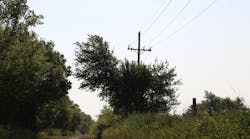Utility rights-of-way are often home to a plethora of weed, brush and tree species — some beneficial and desirable, others not.
While incompatible vegetation can threaten the integrity of utility infrastructure, targeted applications of selective herbicides can support Integrated Vegetation Management (IVM) programs by selectively controlling problematic brush species. This supports the development of early successional habitat that is not only compatible with ROW corridors but also surrounding wildlife.
Results from decades of State Game Lands 33 (SGL 33) research have showcased these benefits. In fact, findings shared at the 2022 ROW Sustainability Summit suggest that using selective herbicide applications as part of an IVM-based approach can be the key to increasing pollinator populations and supporting the development of tree-resistant ground cover that can impede incompatible plant growth throughout utility ROW.
Selective herbicide applications allow vegetation managers to effectively target incompatible vegetation without causing harm to desirable plant species. This enhances the long-term development of biodiverse wildlife habitat. As a result, industry leaders can achieve results that not only benefit electrical service reliability and environmental sustainability, but also their reputation and bottom line.
Carbon Emissions
Other studies supporting SGL 33 research indicate that herbicide applications can help utility companies decrease their carbon footprint. Asplundh Tree Expert recently analyzed the amount of carbon emissions produced by common vegetation control strategies across 15 test plots. This research revealed two noteworthy insights:
1. Mowing produced the most carbon emissions – by far. Mechanical mowing required significantly more fuel than all other control methods tested. The 24 gallons of fuel required for mowing just 3.04 acres equated to carbon emissions of 176.68 lbs./acre, an average approximately eight times higher than high-volume foliar herbicide applications.
2. Herbicide applications required significantly less time to complete Low-volume basal, low-volume foliar and high-volume foliar herbicide applications significantly outperformed their field plot counterparts in terms of efficiency. Low-volume basal applications showed an average range of 0.62 acre treated per hour (ac/h) and 0.9 ac/h, while the two plots featuring high-volume foliar applications covered 0.7 ac/h and 3.06 ac/h, respectively. In comparison, mechanical mowing covered just 0.51 ac/h while hand-cutting practices yielded a slow-moving range of 0.04 ac/h to 0.09 ac/h.
Tree-resistant Cover Types
As incompatible trees and woody plant species pose a threat to interfere with overhead transmission lines, SGL 33 researchers tested several vegetation control strategies to identify best practices for the establishment of tree-resistant cover types.
Supporting the development of beneficial grasses and forbs can help vegetation managers create a natural barrier against the reestablishment of incompatible plant species, which can significantly reduce common threats to the integrity of utility infrastructure.
Results from SGL 33 research indicate that using selective herbicide applications as part of an IVM-based strategy can significantly reduce incompatible stem densities throughout utility ROW corridors. As a result of applying these practices throughout their managed land, vegetation managers can achieve the following benefits:
- Enhanced electrical transmission reliability
- Lower costs associated with ROW maintenance
- Development of low-growing plant communities throughout the wire zone
- Establishment of low-growing tree saplings in the border zone
- Biodiverse habitat development for native wildlife species
To learn more about SGL 33 research and industry-leading strategies that help utility vegetation managers enhance biodiversity and the reliability of electrical service, visit HabitatWithHerbicides.com.
™ ® Trademarks of Corteva Agriscience and its affiliated companies.
Sponsored By:



